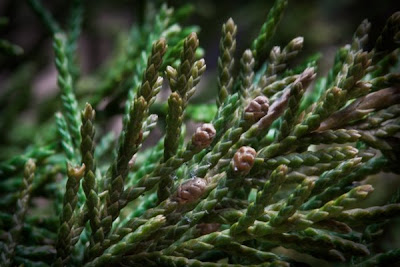It's just
so exciting to identify an unknown creature. Yesterday's mystery, Buttonbush,
Cephalanthus occidentalis, was solved with the aid of my new book,
The Shrub Identification Book. Remember? This was the book made famous in the mystery shrub case? Although not those nice line drawings that I like so much, the black and white life size photos do get out the features that work so well for me.
I've recently delved into the work of wildlife biologist John Eastman, author of
The Book of Swamp and Bog. One can hardly open this book to any page and not find a wonderful pen and ink sketch nicely detailed by artist Amelia Hansen. This book will not help with identification, just like my Shrub ID won't provide any fascinating details. For instance, the Buttonbush takes up three full pages and three sketches!
Within the three Buttonbush pages, there are details on plants likely to be neighboring with our specimen. There are details on insects that assist, attack, and defend the plant. There is lore on medicinal uses. The birds who eat the seeds.
I began this project with the intent of listing each and every plant, bird, mammal. I'm coming to see the natural community around me, the symbiotic to parasitic supports and dependencies of all my lake creatures. I don't know yet how I will learn to tie this all together but that intent is now within. You know, when I see a bush that I can now identity, I give a silent little hello. At the same time, I know that a label is not knowledge, but yet the labeling process is experience.
I've had this thought for an organzied list of my plant books. I even set up an Associate account with Amazon.com so that I could collect a percentage of sales through this blog. It's the programmer/analyst in me. For now, I've decided that I'll forget about Amazon and regimented lists and simply label posts about books with, well, 'Book'. Click on that entry in the index and there's my list. Simple!
I'm a little light on pictures this evening. I mean, I could put out a shot of another mystery but I'd need more and better photos to make an ID. Tomorrow I plan to get out and pick up some new shots. So, until then, here's one I didn't have to go traipsing through the snow for. I shot this waxing gibbous just before December's full moon. And although I didn't know it at the time, this was to be a perigee full moon,the biggest and brightest full moon of the year.














































